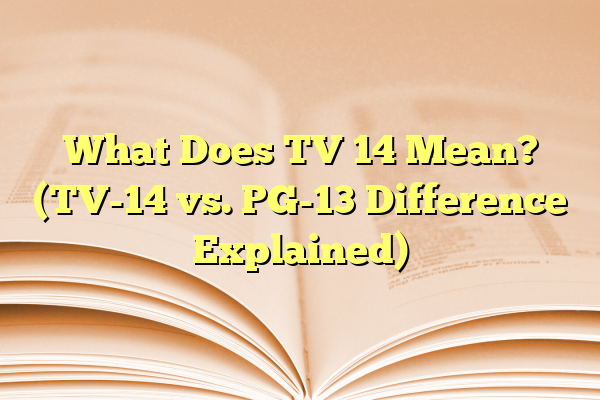
What Does TV 14 Mean? (TV-14 vs. PG-13 Difference Explained)
In today’s world of entertainment, understanding content ratings is more important than ever for parents, educators, and viewers who want to make informed choices. With the abundance of shows and movies accessible through cable TV, streaming services, and digital platforms, the differences between television and movie rating systems can often cause confusion. A common question arises: What does TV-14 really mean, and how does it compare to a PG-13 movie rating?
Contents
TLDR: Understanding TV-14 vs. PG-13
TV-14 is a television content rating that signifies a program may be unsuitable for children under 14, often due to content involving strong language, intense violence, or suggestive dialogue. In contrast, PG-13 is a movie rating that advises parental guidance for children under 13. Though both appear similar, they are regulated by entirely different systems and standards. Understanding the distinction is key for parents seeking to monitor what their children watch across different media platforms.
Understanding the TV Parental Guidelines System
The TV Parental Guidelines were introduced in the United States in 1997 as a way to inform viewers about television program content. These guidelines are entirely voluntary and were developed in cooperation with the television industry, the Federal Communications Commission (FCC), and advocacy groups. Each rating is meant to help parents make informed viewing decisions for their children.
The primary ratings include:
- TV-Y: Suitable for all children
- TV-Y7: Suitable for children age 7 and older
- TV-G: Suitable for general audiences
- TV-PG: Parental guidance suggested
- TV-14: Parents strongly cautioned – may be unsuitable for children under 14
- TV-MA: Mature audiences only
What Does TV-14 Mean?
TV-14 is a content rating that tells viewers the program is intended for audiences aged 14 and older. While younger viewers may watch these programs, parents are strongly cautioned due to the potential inclusion of content that is unsuitable for children under the age of 14.
TV-14 programs can feature:
- Moderate to strong coarse language
- Intense sexual content or suggestive themes
- Moderate to strong violence
- Frightening or disturbing scenes
The TV-14 rating may also include secondary labels to help clarify the nature of the content. These are:
- D: Suggestive dialogue
- L: Coarse/inappropriate language
- S: Sexual content
- V: Violence
- FV: Fantasy violence (used only with TV-Y7)
For example, a show rated TV-14-LSV would contain language, sexual content, and violence that may be considered strong or intense.

The Motion Picture Association (MPA) Rating System Explained
Distinct from television ratings, the Motion Picture Association (MPA) administers film ratings. These ratings are applied to theatrical releases and serve as a guideline for parents deciding which movies they deem appropriate for their children.
The MPA ratings include:
- G: General audiences – all ages admitted
- PG: Parental guidance suggested – some material may not be suitable for children
- PG-13: Parents strongly cautioned – some material may be inappropriate for children under 13
- R: Restricted – under 17 requires accompanying parent or adult guardian
- NC-17: No one 17 and under admitted
PG-13 specifically suggests that some material—such as brief strong language, sexual references, or violence—may not be suitable for children under 13. However, PG-13 content is generally more restrained than R-rated content. The rating provides a middle ground between children’s movies and more mature content.
TV-14 vs. PG-13: Key Differences
Although TV-14 and PG-13 may look similar on the surface, their differences are significant:
| Aspect | TV-14 | PG-13 |
|---|---|---|
| Media Type | Television, streaming shows | Theatrical films, some home video |
| Administering Body | TV Parental Guidelines, in cooperation with FCC | Motion Picture Association (MPA) |
| Suggested Age | 14 and older | 13 and older |
| Content Intensity | Can include sexual situations, strong language, and violence | Usually tamer; may include brief strong language or moderate violence |
One major difference is that film ratings like PG-13 are enforced by many theaters, which may require adult accompaniment for younger viewers. In contrast, TV-14 relies on parental discretion and household enforcement.

Why the Distinction Matters
With the growing overlap between television and film through streaming services like Netflix, Hulu, and Disney+, the distinction between TV-14 and PG-13 ratings becomes more important than ever. Parents may mistakenly assume that a PG-13 film and a TV-14 show are equivalent in content and accessibility, but this is not always the case.
For instance, a TV-14-rated series may include recurring violent scenes or sexual situations that surpass the level typically acceptable in a PG-13 film. The ongoing nature of episodes also means cumulative exposure to more mature content compared to a one-time movie experience.
Enforcing Content Controls
Both televisions and streaming platforms now offer various parental control options. Users can often restrict access based on rating systems to protect younger viewers from inappropriate content. Understanding what each rating means allows for more effective use of these controls.
Tips for managing viewing habits include:
- Setting parental locks based on rating levels
- Reviewing program descriptions and content warnings
- Watching programs together to gauge appropriateness
- Using third-party rating sites for detailed content breakdown
Context Is Key
It’s also essential to consider the context of content. A violent scene in a historical drama may serve an educational purpose, while similar violence in an action thriller could be more gratuitous. Therefore, ratings provide a helpful framework, but parental involvement remains crucial.
Conclusion
Understanding the difference between TV-14 and PG-13 can help you make more informed decisions as a viewer and a parent. While both ratings aim to protect younger audiences from inappropriate content, they originate from different systems and apply to different forms of media. Their standards, enforcement, and implications vary in meaningful ways.
As content continues to evolve and blur lines between television and film, being aware of these distinctions and taking advantage of available tools can lead to a safer and more enjoyable viewing experience for everyone.
